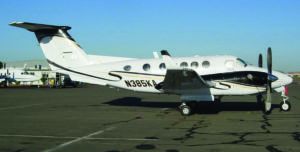One thing I’ve had a visceral reaction to over the years is when popular media describe a certificated pilot who flies for personal reasons as an “amateur.” Over the years, I’ve more or less accepted such usage but—when given the chance—point out that the type of operation has no bearing on pilot skill levels, and that acting as a professional, the opposite of an amateur, doesn’t require compensation.
In other words, professionalism is a state of mind—not at all dissimilar from amateurism—and has more to do with how one goes about performing tasks than it does with the tasks themselves. Rather than the binary choice of “-isms” forced upon us, it’s clear to me that professionalism is more analog than off or on.
Of course, defining professionalism in aviation is problematic but one of its obvious characteristics is to be physically and emotionally well enough to perform cockpit and other tasks. That’s true in all cases but is especially so when taking off in a new-to-you aircraft.
Background
On January 23, 2017, at about 1233 Mountain time, a Beech 300 Super King Air was destroyed when it impacted terrain shortly after takeoff from the Tucson (Ariz.) International Airport. The 56-yearold airline transport pilot and the passenger were fatally injured. Visual conditions prevailed; the airplane was departing on an IFR flight plan to Sonora, Mexico.
A witness about 0.7 mile southwest of the midfield of the departure runway observed the airplane rapidly pitch up during initial climb. At between 100 to 150 feet above the runway, the airplane yawed to the left in a nose-up pitch attitude. The airplane then appeared to slow. It entered a left roll as the nose dropped and the airplane struck the ground inverted.
Another witness, located near the departure runway’s approach end, described the airplane yawing from left to right while climbing. The airplane then rolled left and became inverted, in a manner he described as similar to a barrel roll.
Investigation
The airplane came to rest against an eight-foot-high concrete wall on the ramp adjacent to the airport’s south terminal. The initial impact point was about 4000 feet from the departure end of the runway, and some 650 feet across the ramp to the main wreckage. A postimpact fire erupted. All major structural components of the airplane were located in the wreckage and debris path.
Propeller slash marks suggested rotation at or near their rated speed of 1700 rpm at the estimated impact velocity. The blades of both propellers had deep chordwise/ rotational scoring on their camber sides. In comparing damage between the propellers, the right propeller had damage suggesting it was operating at a higher blade angle and power than the left propeller.
Both engines exhibited rotational scoring signatures indicating they were producing symmetrical power and were most likely operating in their mid- to upper-power range at impact. The engines did not display preimpact anomalies that would have precluded normal operation.
Flight control continuity was established from the cockpit controls to the associated component. The right and left elevator trim actuators corresponded to a 10-degree tab-down position. There were no discrepancies noted that would have prevented or degraded normal operation before impact.
The day before the accident, the airplane was flown from Long Beach, California, to Tucson as a pre-buy and post-maintenance test flight before its owner sold it. The flight was conducted by the seller’s contract pilot, with the accident pilot and a pilot-rated passenger on board. According to the contract pilot, the accident pilot did not fly the airplane on the flight to Tucson. After the flight, transactions were performed and the airplane’s ownership was transferred. The accident flight apparently was the first one under the airplane’s new ownership.
The accident pilot held multiple type ratings, including for the BE300. Between 1979 and 1988, he served on active duty in the U.S. Air Force, and later flew in Afghanistan and Iraq as a military contract pilot and as a captain for various companies in Africa and Saudi Arabia. In October 2016, the pilot reported to an employer total flight experience of 15,100 hours, including 13,000 hours as pilot-in-command.
Given the departure runway and local conditions, the airplane experienced a 12- to 14-knot right crosswind and a four-knot tailwind— based on sustained winds—and a 21-knot right crosswind and a six-knot tailwind based on the peak wind gusts.
Toxicology testing revealed the pilot’s use of multiple psychoactive substances including marijuana, venlafaxine, amphetamine, pseudoephedrine, clonazepam and pheniramine.
Probable Cause
The NTSB determined the probable cause(s) of this accident to include: “The pilot’s exceedance of the airplane’s critical angle of attack during takeoff, which resulted in an aerodynamic stall. Contributing to the accident was the pilot’s impairment by the effects of a combination of psychoactive substances.”
According to the NTSB, “The wide variety of psychoactive effects of these medications precludes predicting the specific effects of their use in combination. However, it is likely that the pilot was impaired by the effects of the combination of psychoactive substances he was using and that those effects contributed to his loss of control. The investigation was unable to obtain medical records regarding any underlying neuropsychiatric disease(s); therefore, whether these may have contributed to the accident circumstances could not be determined.”
The NTSB’s report seems to gloss over two areas: One, this apparently was the first time the pilot had flown this particular airplane. While accidents involving recently acquired aircraft is a much larger topic, it deserves attention. Two, the elevator trim was set to a seemingly inappropriate nose-up position, and could have resulted in the kind of behavior witnessed, as could failure to remove the control lock.
On paper, most observers would label the accident pilot as a professional. But true professionals don’t endanger others by keeping a disqualifying medical condition hidden, or toke up on top of a smorgasbord of other drugs, and then go fly an airplane.
Aircraft Profile: Beechcraft 300 Super King Air
OEM Engines: P&WC PT6A-60A
Empty Weight: 8838 lbs.
Maximum Gross Takeoff Weight: 14,000 lbs.
Typical Cruise Speed: 300 KTAS
Standard Fuel Capacity: 539 gal.
Service Ceiling: 35,000 feet
Range: 1761 NM
VS0: n/a
Disqualifying Medications
The FAA has a long-understood list of medications that either disqualify a pilot from obtaining or renewing a medical certificate, or require a waiting period after the last dose before flying. Approving a new drug’s use for aeromedical certification purposes typically requires a year to elapse after FDA approval before it will be considered.
Some highlights are below, but you always should consult your AME about any new prescriptions.
- Controlled substances, including medical marijuana.
- Psychiatric or psychotropic medications like antidepressants (certain SSRIs may be allowed), antianxiety or antipsychotic drugs, stimulants and tranquilizers.
- Seizure medications.
- Smoking cessation aids.
- Steroids in high doses.
- Weight loss medications.
Jeb Burnside is the editor-in-chief of Aviation Safety magazine. He’s an airline transport pilot who owns a Beechcraft Debonair, plus the expensive half of an Aeronca 7CCM Champ.
This article originally appeared in the January 2020 issue of Aviation Safety magazine.
For more great content like this, subscribe to Aviation Safety!





































Great article. I particularly like the author’s last summarizing sentence, “But true professionals don’t endanger others by keeping a disqualifying medical condition hidden, or toke up on top of a smorgasbord of other drugs, and then go fly an airplane.” I just can’t imagine why someone would do this or how they could rationalize this sort of behavior to themself. Such a state of denial! Scary!
Agreed. I’d never heard of some of the meds, so I looked them all up. Marijuana (a depressant), an antidepressant, two types of stimulants, a drug for panic disorders, and a weight loss drug. Wow. Any one of those would have been disqualifying, but all together? He shouldn’t have been driving a car, let alone flying an airplane.
I agree with Jeb’s conclusion: this pilot was no professional. I don’t get paid when I get in the cockpit, but I do my damndest to be as professional as I can be. Every time I read a story like this, it reinforces the need to do so.
Hmmm. This individual held an ATP, so theoretically was getting approval from an AME for a Class 1 medical certification. Yet somehow, it’s this kind of incident that is often used as evidence to justify the need for government-mandated flight physicals.
That aside, we bemoan the lack of judgement exhibited by someone wasted on drugs that, in part, destroy one’s ability to exercise judgement. But what about everyone else? What I find very difficult to believe is that any of the many people–including the passenger–who must have interacted with this person before he got in the aircraft failed to notice anything out of whack.
It seems the FAA is quick to claim accidents are the result of drugs if any are found. Was this really the issue, or where there training or performance issues that the FAA didn’t investigate.
A great article and analysis. Only one comment on the media. Most media reports on aircraft accidents are given by reporters that know very little, if anything, about flying or aviation in general. Their lack of knowledge on the subject is obvious to those of us who have flown an aircraft and/or worked in the aviation industry.
It’s unlikely that the control locks could have been left in place. The BE-300 control lock system is made up of a combination of separate pins for the yoke and rudder, as well as a “sugar pincer” for the engine controls, all linked together by an impressively unwieldy chain arrangement. If the rudder and engine control portions were removed but not the yoke pin, the whole dangling arrangement would very noticeably interfere with the pilot occupying the left seat.
An improper takeoff pitch trim setting, such as the pitch trim being inadvertently left in the landing position, could conceivably be at fault. This error could contribute to other factors/failures being more dangerous than they would otherwise be.
As unlikely as it may seem, I recall a First Officer failing his Part 121 Captains upgrade in a Beech 1900 for exactly that. He taxied to the runway and lined up on centerline. The check airman asked, “are you ready?”. Check ride over! There it was a large metal plate dangling on a chain between his legs with the words, “Remove Before Flight”. He had two opportunities to catch his mistake on the checklist, a checklist he had read 100’s of times as a First Officer prior to upgrade. I doubt he was under the influence of anything more than check ride anxiety.
Getting lax in following the most basic rules, like allowed medication and health, is sadly common in all fields of transportation, and the old pros are no less affected than the young tyros.
Just because you have done it before without any problems makes it safe to do it again!
As pilots, I believe we understand that there’s an assumed, and reasonably practiced “zero tolerance” with everything intoxicating.. But, that undeniable reality, when talking about “professionalism”, is the complex issue of human behavior.. Can we automate out the effects of a intoxicated pilot ..?